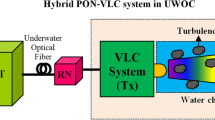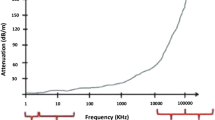Abstract
Underwater LED based Optical Communication has immense applications in the marine, autonomous underwater vehicle drivers and military fields. Compared with traditional underwater acoustic communication LED based optical communication offers secure, very high data rates (in ~ Gbps), and short wavelength which makes the antenna size of transmitter and receiver relatively small. In this paper an experimental setup of underwater LED (using Red, Green and Blue color) based optical communication in a 39 × 8 × 12 inches tank is designed to achieve data rates of 2 Mbps at a distance of 1 m. Furthermore, the performance comparison of free space and underwater optical link using ASK, FSK and PSK is made along with NRZ line encoding scheme. The results are presented and discussed in terms of eye diagrams and bit error rates. The experimental results reveal that the blue color LED has best received signal strength in comparison to the green and red LEDs in underwater medium. All three LEDs achieve a bit error rate of around 10−5 with blue LED achieving highest SNR of 22.5 dB.













Similar content being viewed by others
References
Cossu, G., et al. (2013). Experimental demonstration of high speed underwater visible light communications. In Second IEEE international workshop on optical wireless communications (pp. 11–15).
Giles, J. W., et al. (2005). Underwater optical communications systems. Part 2: basic design considerations. In MILCOM 2005–2005 IEEE military communications conference (Vol. 3, pp. 1700–1705). Atlantic City, NJ.
Zeng, Z., Fu, S., Zhang, H., Dong, Y., & Cheng, J. (2017). A survey of underwater optical wireless communications. In IEEE communications surveys & tutorials (Vol. 19(1), pp. 204–238), Firstquarter.
Chaplin, M. (2016). Water absorption spectrum. Available: http://www1.lsbu.ac.uk/water/water_vibrational_spectrum.html. Accessed 2 Oct 2017.
Kaushal, H., & Kaddoum, G. (2016). Underwater optical wireless communication. In IEEE access (Vol. 4, pp. 1518–1547).
Khan, L. U. (2017). Visible light communication: Applications, architecture, standardization and research challenges. Digital Communications and Networks, 3(2), 78–88.
Farr, N. E., Pontbriand, C. T., Ware, J. D., & Pelletier, L. P. A. (2016). Non-visible light underwater optical communications. In 2016 IEEE 3rd underwater communications and networking conference (UComms) (pp. 1–4), Lerici.
Haltrin, V. I. (1999). Chlorophyll-based model of seawater optical properties. Applied Optics 38(33).
Komine, T., & Nakagawa, M. (2004). Fundamental analysis for visible light communication system using LED lights. IEEE Transactions on Consumer Electronics, 50(1), 100–107.
Karunatilaka, D, Zafar, F., Kalavally, V., & Parthiban, R. (2015). LED based indoor visible light communications: State of the art. In IEEE communication surveys & tutorials (Vol. 17(3)). Third Quarter 2015.
Wen, D., Cai, W., & Pan, Y. (2016). Design of underwater optical communication system. In OCEANS 2016-Shanghai (pp. 1–4), Shanghai.
Wang, M., Wu, K., & Xu, H. (2015). A data-rate-regulable UWOC system using RZ-OOK modulation. In 2015 IEEE 9th international conference on anti-counterfeiting, security, and identification (ASID) (pp. 137–140), Xiamen.
Gayathri, C. B., Singh, D., Durga, S. D. M., & Narendara R. V. (2015). Design of high speed underwater optical communication using on–off keying algorithm. In 2015 international conference on communications and signal processing (ICCSP) (pp. 1355–1360), Melmaruvathur.
Yagimli, M. (2011). Design of laser based underwater communication system. Journal of Naval Science and Engineering, 7(2), 1–10.
Meihong, S., Xinsheng, Y., & Zhangguo, Z. (2009). The modified ppm modulation for underwater wireless optical communication. In 2009 international conference on communication software and networks (pp. 173–177), Macau.
Jasman, F. & Green, R. J. (2013). Monte Carlo simulation for underwater optical wireless communications. In 2013 2nd international workshop on optical wireless communications (IWOW) (pp. 113–117), Newcastle upon Tyne.
Kaushal, H., & Kaddoum, G. (2016). Underwater optical wireless communication. In IEEE access (Vol. 4, pp. 1518–1547).
Szili, T., Balázs, M., & Gábor, F. (2015) Water pollution investigations by underwater visible light communications. In 17th international conference on transparent optical networks (ICTON). IEEE.
Ali, M. A. A. (2015). Characteristics of optical channel for underwater optical wireless communication system. ISOR Journal of Electrical and Electonics Engineering, 10(2), 01–09.
Acknowledgements
The authors would like to thanks lab staff of optical communication laboratory, Department of Telecommunication Engineering, and Institute of Environmental engineering of Mehran University of ET, Jamshoro, Pakistan to help us testing the performance of underwater optical link.
Author information
Authors and Affiliations
Corresponding author
Additional information
Publisher's Note
Springer Nature remains neutral with regard to jurisdictional claims in published maps and institutional affiliations.
Rights and permissions
About this article
Cite this article
Mangrio, H.B., Baqai, A., Umrani, F.A. et al. Effects of Modulation Scheme on Experimental Setup of RGB LEDs Based Underwater Optical Communication. Wireless Pers Commun 106, 1827–1839 (2019). https://doi.org/10.1007/s11277-018-5718-1
Published:
Issue Date:
DOI: https://doi.org/10.1007/s11277-018-5718-1




